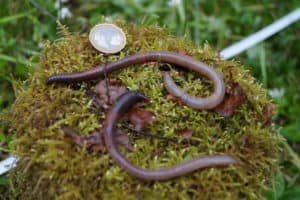
The world’s boreal forests have been largely earthworm-free since the last Ice Age. But as invaders arrive and burrow into the leaf litter, they free up carbon and may accelerate climate change.
Credit: Cristina Gonzalez Sevilleja
Cindy Shaw, a carbon-research scientist with the Canadian Forest Service, studies the boreal forest — the world’s most northerly forest, which circles the top of the globe like a ring of hair around a balding head.
A few years ago, while conducting a study in northern Alberta to see how the forest floor was recovering after oil and gas activity, she saw something she had never seen there before: earthworms.
“I was amazed,” she said. “At the very first plot, there was a lot of evidence of earthworm activity.”
Native earthworms disappeared from most of northern North America 10,000 years ago, during the ice age. Now invasive earthworm species from southern Europe — survivors of that frozen epoch, and introduced to this continent by European settlers centuries ago — are making their way through […]











I love earthworms! My grandfather always said that if you can reach into your garden soil and find lots of earthworms, your plants will grow profusely and the carbon they give off will feed the plants which need it to flourish and the remnants of their castings they leave behind are good food for the roots of your garden plants. They only come to the surface when heavy rains fill their tunnels where they live and they need oxygen to survive, so they come to the top layer only when it is too wet. They are a great boon to any garden and mankind in general. Just plant in the areas where there are earthworms and you will see your garden produce like it never could otherwise. Earthworms are wonderful creatures for gardeners, and they are my best friends.